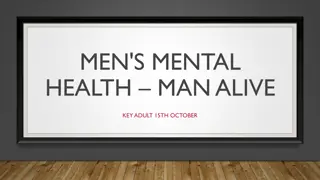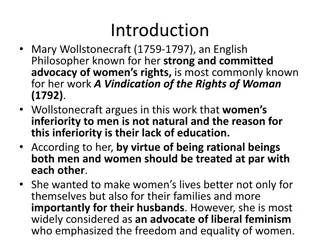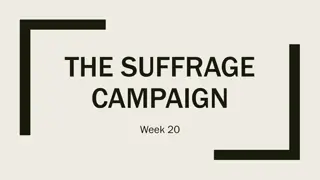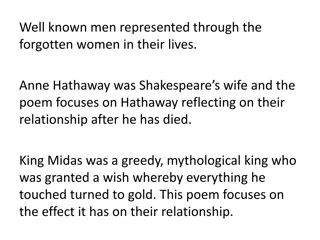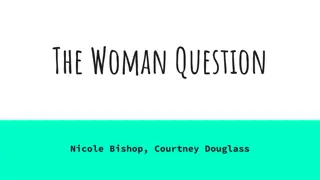
Exploring Differences Between Men and Women | Learning Resources
Engage in activities to identify and discuss differences between men and women regarding attitudes, roles, skills, and more. Improve speaking, vocabulary, grammar, reading, and writing skills through interactive lessons. Express opinions, practice grammar summaries, and write sentences to enhance understanding. Explore definitions of words related to neuroscientist, species, myth, multitasking, cosmetics, trait, gene, linguistics, shade, and spatial ability.
Download Presentation

Please find below an Image/Link to download the presentation.
The content on the website is provided AS IS for your information and personal use only. It may not be sold, licensed, or shared on other websites without obtaining consent from the author. If you encounter any issues during the download, it is possible that the publisher has removed the file from their server.
You are allowed to download the files provided on this website for personal or commercial use, subject to the condition that they are used lawfully. All files are the property of their respective owners.
The content on the website is provided AS IS for your information and personal use only. It may not be sold, licensed, or shared on other websites without obtaining consent from the author.
E N D
Presentation Transcript
Women and Men Women and Men Neermediate rmediateLesson New Internationalist Ready Lesson Upper Intermediate Lesson nationalist Easier English Ready Intermediate Lesson
This lesson: This lesson: speaking vocabulary ragmarm reading writing
With a partner make a list of differences you think there are between men and women: attitudes roles differences skills
she or he? 1) ___ has just been promoted to director. 2) ___ took a small chocolate and giggled, How naughty of me! 3) The nurse took us to the ward amd then --- asked us to wait. 4) With great pride ____ showed us the new table ____ had been making. 5) ___ drove the children to school. 6) ___ was 80 and lived alone. 7) ___ drove a big car. 8) When ___ is talking, I can t get a word in edgeways!
Opinions Opinions Talking in general. Make 5 sentences using one Talking in general. Make 5 sentences using one of the coloured words in each sentence of the coloured words in each sentence generally drivers tend generalisation better but there is a and say generalise are tendency to be for women it s a we can
Complete the grammar summaries with Complete the grammar summaries with generalise sentence generalisation but generalise sentence generalisation but tend tendency for tend tendency for 1) Generally + ___________________ 2) Subject + __________ + to + infinitive 3) There is a _____________ + _____ + noun + to + infinitive 4) It s a ___________ but + sentence 5) We can _________ and say that + sentence
Write 10 sentences about the differences you Write 10 sentences about the differences you think there are between men and women: think there are between men and women:
Match definitions to the words: Match definitions to the words: 1) neuroscientist 2) species 3) myth 4) multitasking 5) cosmetics 6) trait 7) biologically programmed 8) gene 9) linguistics 10) shade 11) spatial ability a) b) c) d) e) f) g) the science of language an idea or story which is not true fixed from birth lighter or darker form of a colour it s passed on from parents to children make up (noun) ability to do several things at the same time s/he studies the brain a life form person s characteristic ability to work with distances/spaces h) i) j) k)
Text 1: true or false? Read and check: 1)Newspapers prefer to write about gender differences. 2)Women talk three times more than men. 3)It s a myth that women are more talkative than men. 4)Men use 16,000 words a day. 5)Gender differences are less popular now than 10 years ago.
Text 2: True or false? Read and check: Text 2: True or false? Read and check: 1)Women s favourite colour is blue. 2)Men s favourite colour is blue. 3)Women like pink more than men. 4)The media reported the University of Newcastle s study accurately. 5)Advertising influences the colour women prefer.
Text 3: true or false? Read and check: Text 3: true or false? Read and check: 1)Women have a shopping gene. 2)The media are against the idea that women might have a shopping gene. 3)Studies which ask us how we rate ourselves on personality traits are reliable. 4)The media insist on reporting gender differences.
Text 4: true or false? Read and check: Text 4: true or false? Read and check: 1)Men and women s brains work differently. 2)Left- handed and right handed people s brains work the same. 3)Scientists disagree about the way females and males behave. 4)Newspapers ignore science in their reports.
Text 5: true or false? Read and check: Text 5: true or false? Read and check: 1) Newspapers, radio, and TV prefer to tell us about the ways men and women are the same. 2) Tory newspapers are more sexist than liberal newspapers. 3) Readers of newspapers are happy to read about the similarities between genders. 4) Newspapers prefer to entertain their readers rather than tell them the truth about gender studies
Text 1 Newspapers love to write stories about the differences between the sexes, because readers like to read them. Gavin Evans writes about why we still love to read about the differences. I was at a dinner party. People began to talk about that old topic of how women talk a lot and men don t talk so much. A businessman said, It s a fact: ladies talk more. There s a big international study which found that women use three times as many words as men. Actually, there is no study. Louann Brizendine is a Californian psychiatrist. She said in 2006 that men use 7,000 words a day, women 20,000. This is on the cover of her book The Female Brain. Mark Liberman is linguistics professor at the University of Pennsylvania. He decided to study this. He found Louann Brizendine got the information from a self-help book. This self-help book got the information from another book, and so on. And the numbers changed each time. Then Louann Brizendine said, Yes, it is a myth, it isn t true. Soon after, three American universities did a very big study. They put microphones on 396 US and Mexican students and recorded parts of their conversations. The students did not know when the microphones were on or off. Both the men and the women used about 16,000 words a day. One of the researchers, Professor Jamie Pennebaker, said, That old idea is wrong. But the idea that women and men are different was and is more popular ten years later.
Text 2 Pretty in pink or blue? Another study was about the colours men and women prefer. The University of Newcastle decided that it was fixed. They showed people pairs of colours and asked them to choose the colours they preferred by clicking a computer mouse. The favourite colour of both men and women was blue. But the University of Newcastle found their idea worked with the colour pink: women preferred pink more than men. Pretty in pink or blue? Psychologists thought about this and the African savannah when it was the women who looked for food for the family and when it was helpful for them to look for ripe, red fruits. But it is difficult to explain why women preferred pink. But most of the world s media welcomed the results. Time magazine reported that women may be biologically programmed to prefer pink. The Times wrote, At last science discovers why blue is for boys and that girls really do prefer pink and said that this was because of a deep instinct. A week later Dr Ben Goldacre said the idea was wrong in his Bad Science column in The Guardian newspaper. He explained that the test measured what men and women preferred and not what was useful when looking at different shades of red. But the real evidence was that women only started to prefer pink over the last 75 years as a result of advertising campaigns. Before then people often thought it was a colour for boys. For example, the American Sunday Sentinal said in 1914: Use pink for a boy and blue for a girl, if you follow convention . And the British Ladies Home Journal told readers in 1918 that the general rule was pink for boys, blue for girls. Because pink is a stronger colour, it is more suitable for the boy, but blue is more delicate and is prettier for the girl.
Text 3 A connection does not mean there is a cause A few years ago there was support for the idea that women have a shopping gene . Daniel Kruger at the University of Michigan said that it was women who always wanted to go shopping because it was women who went to look for food. A connection does not mean there is a cause This repeats the myth that women prefer pink and it does not think about other reasons why women seem to want to go shopping. One reason is a culture where most women do more of the household shopping. And advertisers, parents, and other women get them to worry about how they look and then they are interested in clothes and cosmetics. But a lot of the media welcomed the idea. The Hindu wrote Genes dictate shopping styles ; ABC News wrote Why women love to shop and men don t: it s because of evolution . Psychology Today said Shopping brings out our inner hunter/gatherer and the Toronto Sun wrote, What else can you expect from a caveman? . In 2012 several newspapers wrote stories about The University of Manchester s study about differences in personality between the sexes. The study said that men and women share only 10 per cent of personality traits. Psychologically, men and women are almost a different species, said Paul Irwing, one of its authors. The study came from a twenty year old US survey that asked questions about personality traits. But of course we rate ourselves highly on qualities we like. Men know that people think dominance and independence are manly and so they rate themselves highly in these areas. In the same way, women rate themselves highly on feminine qualities like sensitivity and warmth. The most interesting idea from the study is that it showed the opinions of some Americans about themselves in the early 1990s. But the media wrote about the researchers idea that there is a big difference. CBS News wrote: Researchers say there is a big difference between males and females . The Daily Mailwrote: Surprise! Men and women really ARE different: Sexes share just 10 per cent of their personality traits . The Telegraph began: Men and women really do have very different characteristics.
Text 4 Pathways to your brain The conclusions about colours from brain studies that show that men and women use different brain pathways are perhaps the most difficult to disagree with. But left-handed and right-handed people also use different brain pathways, and so do big-headed and small-headed people. Neuroscientist Gina Rippon says: If you have a lot of brains and divide them by sex, you find some differences. But if you divide them by size you find a lot more. Pathways to your brain Three years ago, psychologists at the University of Pennsylvania studied the connections of nearly 100 parts of the brain and concluded there were male and female brains. And that some female brains connected in the male way and some male brains connected in the female way. They concluded that these differences showed differences in behaviour and they said that males have better motor and spatial abilities, but females have better memory and social skills . In fact, many studies show that the better male spatial abilities only come in the teen years. And there is no good evidence that females have better memory, multitasking, or social skills. The fact that men and women may use different brain pathways does not mean their behaviour will be different. The same is true for people who are left-handed or have bigger heads. But again the media were not interested in the science. The LA Times wrote: Brains of women and men show strong differences . The Independent said: The difference between male and female brains could explain why men are better at map reading . And BBC Radio 5 News told its listeners: It is now proved that men and women really do come from different planets.
Text 5 So why do the media love to report on differences between men and women and show no interest in the evidence for similarities? At first, I thought it was because of the sexist ideas of conservative newspapers but I found that liberal newspapers are the same. The reasons are more complicated. Each year, hundreds of studies show no differences between the sexes and newspapers report very few of the studies because similarity is less sexy than difference. Much of the research on differences comes from evolutionary psychologists who are very interested in differences between genders. This is why university press offices promote their studies and newspapers welcome them as lighter topics to fill their pages. One reason the newspapers do this is because readers like to see their own preferences in scientific terms. Women have made progress but many readers feel better when they read reports that talk about the important differences between the genders. So this is why stories with ideas that women evolved to shop or men are too single-minded to multi-task, are very popular. The stories which show no differences or say that studies which show no differences are wrong are boring and even a threat to readers.
Homework Homework Now read the original text: https://newint.org/features/2017/09/01/gender-stereotypes and find words with these meanings: a) describes someone who speaks a lot (paragraph 1) b) describes someone who speaks very little (paragraph 1) c) means to make sure an idea continues (paragraph 3) d) means small pieces of a conversation (paragraph 4) e) means a scientific idea which has clear proof (paragraph 5) f) means an idea which is found not to be true (paragraph 6)





